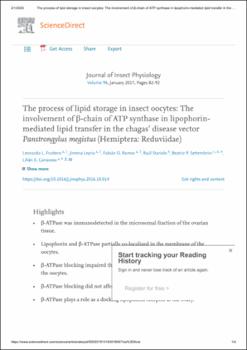The Process of Lipid Storage in Insect Oocytes: The Involvement of β-Chain of ATP Synthase in Lipophorin-Mediated Lipid Transfer in the Chagas' Disease Vector Panstrongylus Megistus (Hemiptera: Reduviidae)

View/
Date
2017-01-01Author
Fruttero, Leonardo.
Leyria, Jimena.
Ramos, Fabián.
Stariolo, Raúl.
Settembrinbi, Beatriz.
Canavoso, Lilián.
Metadata
Show full item recordAbstract
Lipophorin is the main lipoprotein in the hemolymph of insects. During vitellogenesis, lipophorin delivers its hydrophobic cargo to developing oocytes by its binding to non-endocytic receptors at the plasma membrane of the cells. In some species however, lipophorin may also be internalized to some extent, thus maximizing the storage of lipid resources in growing oocytes. The ectopic β chain of ATP synthase (β-ATPase) was recently described as a putative non-endocytic lipophorin receptor in the anterior midgut of the hematophagous insect Panstrongylus megistus. In the present work, females of this species at the vitellogenic stage of the reproductive cycle were employed to investigate the role of β-ATPase in the transfer of lipids to the ovarian tissue. Subcellular fractionation and western blot revealed the presence of β-ATPase in the microsomal membranes of the ovarian tissue, suggesting its localization in the plasma membrane. Immunofluorescence assays showed partial co-localization of β-ATPase and lipophorin in the membrane of oocytes as well as in the basal domain of the follicular epithelial cells. Ligand blotting and co-immunoprecipitation approaches confirmed the interaction between lipophorin and β-ATPase. In vivo experiments with an anti-β-ATPase antibody injected to block such an interaction demonstrated that the antibody significantly impaired the transfer of fatty acids from lipophorin to the oocyte. However, the endocytic pathway of lipophorin was not affected. On the other hand, partial inhibition of ATP synthase activity did not modify the transfer of lipids from lipophorin to oocytes. When the assays were performed at 4 °C to diminish endocytosis, the results showed that the antibody interfered with lipophorin binding to the oocyte plasma membrane as well as with the transfer of fatty acids from the lipoprotein to the oocyte. The findings strongly support that β-ATPase plays a role as a docking lipophorin receptor at the ovary of P. megistus, similarly to its function in the midgut of such a vector. In addition, the role of β-ATPase as a docking receptor seems to be independent of the enzymatic ATP synthase activity.

